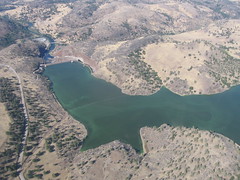 美國聯邦、州政府官員、電力公司主管與原住民議會長老於18日簽署兩份協定,意味著美國史上最大的河流復育計畫──克拉瑪斯(Klamath)河復育計畫及其4座水壩的拆除工作,更趨近於完成階段。這4座水壩為太平洋電力公司(PacifiCorp)所有,其中3座位於加州,1座位於奧勒岡州,生產足夠7萬人使用的電力。然而這些水壩阻絕了350英里長的鮭魚洄游,使其無法上溯產卵。
美國聯邦、州政府官員、電力公司主管與原住民議會長老於18日簽署兩份協定,意味著美國史上最大的河流復育計畫──克拉瑪斯(Klamath)河復育計畫及其4座水壩的拆除工作,更趨近於完成階段。這4座水壩為太平洋電力公司(PacifiCorp)所有,其中3座位於加州,1座位於奧勒岡州,生產足夠7萬人使用的電力。然而這些水壩阻絕了350英里長的鮭魚洄游,使其無法上溯產卵。
兩項協議中,「克拉瑪斯流域復育協定」著重復育與維持野生鮭魚族群數量的行動,以支持內河與海洋漁業,並為流域中的社區與用水戶確保水源的供應。至於「克拉瑪斯流域水電處置協定」,則明定各項研究與一次環境審查的時程,內政部長將考量此協定規定的研究與環境審查結果,審酌拆除4座水壩對的魚類復育是否必要並符合公眾利益,而就此做出決策。
美國國會曾同意在2020年開始拆除4座水壩,兩項協定則為此提供了法律框架。
 內政部長沙拉薩(Ken Salazar)表示:「數年來飽受爭議的克拉瑪斯河,現在成為令人激賞的範例,即透過合作與夥伴關係可以如何解決複雜衝突。在復育美麗河川與其歷史悠久的鮭魚洄游之際,這兩項協定能提供符合當地社區、部落、農民、漁民與其他相關利益者往前邁進的坦途。」
內政部長沙拉薩(Ken Salazar)表示:「數年來飽受爭議的克拉瑪斯河,現在成為令人激賞的範例,即透過合作與夥伴關係可以如何解決複雜衝突。在復育美麗河川與其歷史悠久的鮭魚洄游之際,這兩項協定能提供符合當地社區、部落、農民、漁民與其他相關利益者往前邁進的坦途。」
這兩項協定也因未能保證水壩的拆除而招致批評,但保育團體「美國河川組織」(American Rivers)與「鮭鱒類保護協會」(Trout Unlimited)均肯定拉瑪斯流域水電處置協定是「在謹慎協商下,對水壩拆除提出最具權宜、科學基礎與最可行的路線。」
鮭鱒類保護協會的科學家傑克‧威廉斯(Jack Williams)說:「我們知道這些協定對於魚類的復育有部分風險和不確定性,但經過仔細審視所有條文,我們認為什麼都不做的風險與不確定性更大。」
實施「克拉瑪斯流域復育協定」將在10年的時間耗費約10億美元,將由聯邦政府提供經費。全額中90%以上將用於漁業復育與野放,以及改善魚類生存的水質並增加水量。
水電協定則需要募集4.5億美元的基金,其中的2億美元基金,則是由奧勒岡州立法部門,根據2009年例行立法會期通過的州參議院第76號法案所授權核准的。
歷史上,克拉瑪斯流域是美國西岸鮭魚產量第三大的河流系統,每年孕育的成魚曾經高達110萬隻。
Removal of four dams on the Klamath River and the largest river restoration project in U.S. history moved closer to accomplishment today with the signing of two agreements between federal, state, utility and tribal officials.
The four dams owned by the electric utility PacifiCorp - three in California and one in Oregon - produce enough power for 70,000 people, but they have blocked 350-mile-long salmon runs, preventing the fish from swimming upstream to spawn.
The Klamath Basin Restoration Agreement outlines activities that would restore and sustain wild salmon populations to support in-river and ocean fishing industries and provide water supply certainty to communities and water users in the Basin.
The Klamath Basin Hydroelectric Agreement sets forth the process for studies and an environmental review to inform a decision by the Secretary of the Interior on whether or not the removal of the four dams is necessary for restoration of fish in the Klamath Basin and is in the public interest.
The two agreements provide a framework for removal of the four dams beginning in 2020, provided that Congress approves.
"The Klamath River, which for years was synonymous with controversy, is now a stunning example of how cooperation and partnership can resolve difficult conflicts," said Secretary Salazar. "The agreements provide a path forward to meet the needs of local communities, tribes, farmers, fishermen and other stakeholders while restoring a beautiful river and its historic salmon runs."
The agreements have been criticized because dam removal is not guaranteed, but both groups say the Klamath Hydroelectric Settlement Agreement was "meticulously negotiated to provide the most expedient, science-based and practical route to dam removal."
Scientist Jack Williams with Trout Unlimited said, "We know there is some risk and uncertainty for fish restoration with these agreements; but after taking a hard look at all the provisions, we find far more risk and uncertainty with the status quo."
Implementation of the Klamath Basin Restoration Agreement will cost about $1 billion over 10 years and will be financed by the federal government. More than 90 percent of the total costs will be targeted for fisheries restoration and reintroduction, and enhancing the quality and quantity of water for fish.
The Hydroelectric Agreement calls for the accumulation of a $450 million fund, $200 million of which was authorized by the Oregon State Legislature through the passage of Senate Bill 76 during the 2009 regular legislative session.
Historically, the Klamath Basin was the third most productive salmon river system on the west coast, producing up to 1.1 million adult fish annually.







